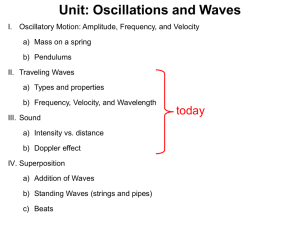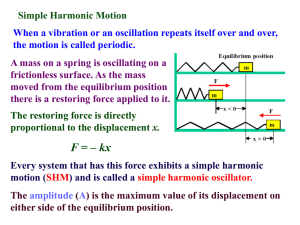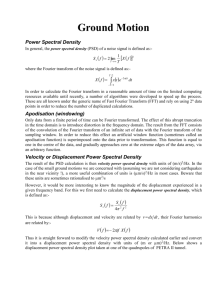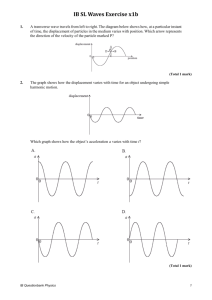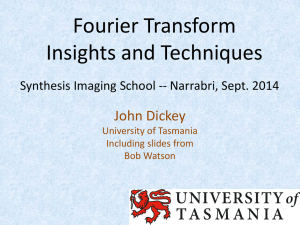lecture32
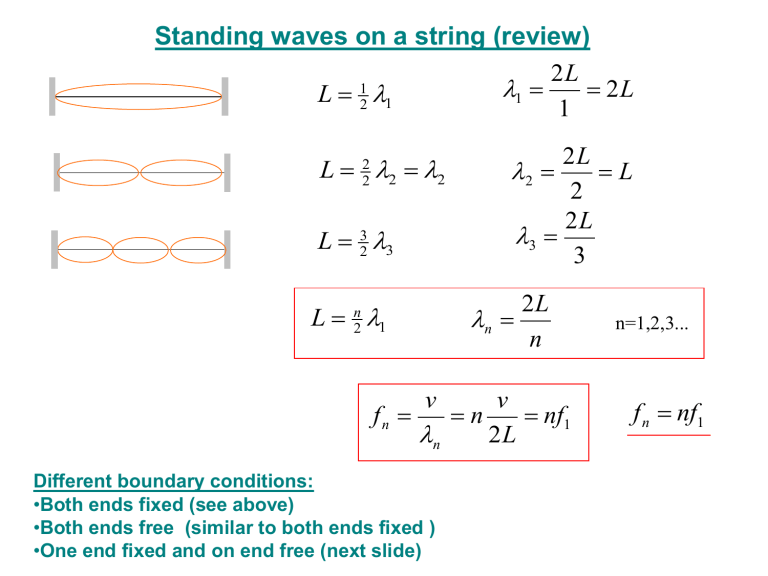
Standing waves on a string (review)
L
1
2
1
1
2 L
1
2 L
L
L
2
2
2
2
3
2
3
2
3
2 L
2
2 L
L
3
L
n
2
1
n
2 L n n=1,2,3...
f n
v
n
v n
2 L
nf
1
Different boundary conditions:
• Both ends fixed (see above)
• Both ends free (similar to both ends fixed )
• One end fixed and on end free (next slide) f n
nf
1
Standing waves on a string (review)
One end fixed and on end free n=1
L
1
4
1 n=3
L
3
4
3
L
n
4
n
n n
4 L n
1 , 3 , 5 ...
v
T n n
n f n f n
v
n
vn
4 L
f
1 n
Standing waves in tubes (longitudinal)
Waves in tubes (pipes) can be described in terms of:
• displacement vibrations of the fluid
• pressure variations in the fluid
A pressure node is a displacement antinode and vice versa
Open and both ends closed pipes
Closed (both ends): displacement pressure
Open: pressure displacement n=1 n=2 n=3 v
T n n
n f n f n
v
n
vn
2 L
nf
1
L
1
2
1
L
2
2
2
L
3
2
3
L
n
2
n
n n
2 L n
1 , 2 , 3 ...
One end open pipes (stopped pipes) displacement pressure n=1
L
1
4
1 n=3 v
T n n
n f n f n
v
n
vn
4 L
f
1 n
L
3
4
3
L
n
4
n
n n
4 L n
1 , 3 , 5 ...
Example: Standing sound waves are produced in a pipe that is 0.6 m long.
For the first overtone, determine the locations along the pipe (measured from the left end) of the displacement nodes. The pipe is closed at the left end and open at the right end.
L
0 .
6 m
3
3
/ 2
4 L
4
3
0 .
4 m
0 .
6 m
3
0 .
8 m
Nodes at 0.0 m and 0.4 m
Sound
Acoustic waves in the range of frequencies: 20Hz -20,000Hz
Sound waves:
• can travel in any solid, liquid or gas
• travel faster in a medium that is more dense
• in liquids and gases sound waves are longitudinal ONLY!
• longitudinal and transversal sound waves could propagate in in solids
Sound in air is a longitudinal wave that contains regions of low and high pressure
Pressure sensor
Vibrating tuning fork
These pressure variations are usually small – a “loud” sound changes the pressure by 2.0x10
-5 atm
Speed of Sound
Speed of waves in strings (review):
v
F
Speed of sound waves:
v
B
B is bulk modulus, defined as
is density dV
V
1
B p
Speed of sound waves in a gas:
B
p
0 is ratio of heat capacities, p
0 is the equilibrium pressure of the gas v
RT
M
Example: Speed of Sound in Air
The speed of sound in an ideal gas is v
RT
, where
M
"ratio of heat capacities"
R molar gas constant
= 8.314 J/mol K
T temperature in K
M molar mass in kg
Air is a diatomic gas, so
1.40 .
The molar mass of dry air, containing about 20% O
2
and 80% N
2
, is
M 0.0290 kg/mol .
Let the ambient temperature be
T 22 °C = 72 °F = 295 K .
Then v
(1.40)(8.31 J/mol K)(295 K)
0.0290 kg
344 m/s
.
This agrees well with experiments.
Speed of Sound in Some Common Substances
Substance Speed (m/s)
1. Air (20 o C) 344
2. Helium 1,006
3. Water 1,140
4. Lead 1,200
5. Human tissue 1,540
6. Aluminum 5,100
7. Iron and steel 5,200
dV
V
y
x dV
V
1
B p
Pressure variations
p
B
y
x y p
A cos
kx
BkA sin
kx
t
t
Example: Displacement Wave Amplitude of Sound in Air
Let the pressure wave amplitude of a sound wave in air at pressure p
0
1.00 atm be p max
0.030 Pa (a typical value). The frequency of the wave is f 1000 Hz and the speed of sound in the air is v 344 m/s .
What is the displacement wave amplitude of the sound wave?
Solution : p max
BAk , so A p max
Bk
(1)
1 atm = 1.013 kPa and = 1.40 for air.
B p
0
(1.40)(1.013
10 5 Pa) 1.42
10 5 Pa. (2) k
v
and 2 f , so k
2 f v
(3)
Putting (3) and (2) into (1) gives
A p max v
2 Bf
(0.030 Pa)(344 m/s)
2 (1.42
10 5 Pa)(1000 Hz)
1.2
10 8 m 12 nm .
Properties of Sound
We classify sounds according to their waveforms:
A “pure tone” is a sound with a sinusoidal waveform.
- This is a sound with a single frequency; produced by tuning fork, etc.
A “complex tone” is a sound that repeats itself but is not sinusoidal
Most sounds are like this!
A note from a musical instrument will be mostly sinusoidal, but have a character all its own that is specific to the instrument.
“Noise” is sound with a complex waveform that does not repeat
No definite wavelength or frequency piano note
Perception of Sound
We use three qualities to characterize how we perceive sound:
1. Pitch. 2. Loudness. 3. Tone quality.
1. The pitch of a sound is how “high” or “low” we perceive a sound to be
(directly related to how we perceive frequency); combinations of notes that are “pleasing” to the ear have frequencies that are related by a simple wholenumber ratio (Pythagoras)
2. The loudness of a sound is how we perceive the amplitude of the sound wave
The unit of sound loudness is the decibel (dB)
Quiet: 30 dB; Moderate: 50 dB; Noisy: 70 dB; Very loud: 90 dB; Problems: 120 dB
3. The tone quality of a sound is how we distinguish sounds of the same pitch and loudness (how we perceive the qualities of the waveform)
Musical Instruments
Anything that causes pressure vibrations creates sound!
Stringed musical instruments produce sound by vibrating a wire or string
A plucked string on a guitar produces a different sound than a violin
The tension in the string is used to adjust the wave speed and the frequency
Wind instruments produce sound by pressure waves in a tube
The sound reflects partly at the open end
Valves change the effective length of the tube
Complex Waves
To produce a pure fundamental tone on a guitar string:
Pluck a guitar string in the middle:
Pull the template away fast.
Then the string will vibrate in its fundamental mode.
Fourier Theorem: The initial shape is a superposition of the sinusoidal shapes for the fundamental mode and for higher harmonics.
The sound produced is the fundamental frequency plus higher harmonics.
Different musical instruments sound different even when playing the same tone partly because the harmonic contents are different.
Fourier Analysis
Fourier Analysis
"Fourier analysis" allows the amplitudes A n to be determined from y ( x , t 0) (see text supplement "Waves"). For our y ( x , t 0), one obtains:
A n
A n
8 A
2 n 2
if n is odd
0 if n is even
.
Fourier Theorem for an Even Function y ( x , t 0)
n =0
A n cos( k n x )
Two fixed ends: k n
2
n
and n y ( x , t 0)
n =0
A n cos
n
L x
.
2 L
, so n

